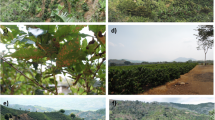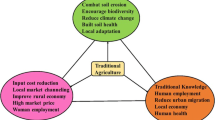Abstract
Northeast India is rich in Citrus genetic diversity representing several wild and cultivated species. Besides commercially cultivated species, several wild, semi-wild and domesticated species namely Citrus indica, C. macroptera, C. ichangensis, C. latipes, C. megaloxycarpa and C. assamensis are found to grow in Northeast India. These species have great potential in improvement of Indian Citrus industry being source of genes for combating biotic and abiotic stresses. The natural diversity of these genetic resources is shrinking at alarming rate due to large scale deforestation, shifting cultivation practiced in these areas and climate change scenario in this important hotspot of biodiversity. Socio-economic importance of each species have been studied during surveys and interesting domestication trends were observed based on their cultural and economic significance, which led to “in situ on farm” conservation of C. indica, C. macroptera and threat to C. megaloxycarpa and C. ichangensis. Consequently, genetic resources of most of these species are facing severe threat of extinction necessitating policy interventions and adoption of dynamic conservation and management strategies. Species specific conservation strategy especially through “in situ on farm” conservation has been proposed with suitable sites in Northeastern Indian states based on population structure and suitability of habitat. Farmers’ support through “The Biological Diversity Act, 2002” and “The Protection of Plant Varieties and Farmers’ Rights Act, 2001” of India would bring the required impact on management of these complex genetic resources of Citrus. In the present study, we have documented the current status, socio-economic potential, domestication trends and associated traditional knowledge of these wild and semi-wild Citrus species occurring in Northeast India and enumerated suitable conservation strategies and desired policy interventions for their dynamic conservation and sustainable utilization.






Similar content being viewed by others
References
Ahuja A (1996) Loss of biodiversity and need for conservation. In: Gujral GS, Sharma V (eds) Changing perspectives of biodiversity status in the Himalaya. The British Council, New Delhi, pp 131–138
Anonymous (2001) The protection of plant varieties and farmers’ rights Act, 2001 (No. 53 of 2001). Universal Law Publishing Co. Pvt. Ltd., New Delhi, India
Anonymous (2004) The biological diversity Act, 2002 and biological diversity rules, 2004, National Biodiversity Authority (2004). Frontline Offset Printers, Triplicane, Chennai, India, pp 57
Anonymous (2009) Food and agricultural organization of United Nations. Economics and Social Departments: The Statistical Division (FAOSTAT/FAO), (http://www.faostat.fao.org)
Anonymous (2010) Consolidated update of the global strategy for plant conservation 2011–2020. Conference of the parties to the convention on biological diversity, tenth meeting, Nagoya, Japan, 18–29 Oct. 2010 (UNEP/CBD/COP/DEC/X/17)
Araujo EF, Queiroz LP, Machado MA (2003) What is Citrus? Taxonomic implications from a study of cp-DNA evolution in the tribe Citreae (Rutaceae subfamily Aurantioideae). Org Divers Evol 3:55–62
Babar ZM (1519) The memoirs of Babar. (English translation)
Barkley NA, Roose ML, Krueger RR, Federici CT (2006) Assessing genetic diversity and population structure in a Citrus germplasm collection utilizing simple sequence repeat markers (SSRs). Theor Appl Genet 112:1519–1531
Barrett HC, Rhodes AM (1976) A numerical taxonomic study of affinity relationship in cultivated Citrus and its closed relatives. Syst Bot 1:105–136
Bayer RJ, Mabberley DJ, Morton CM, Cathy H, Sharma IK, Pfeil BE, Rich S, Hitchcock R, Sykes S (2009) A molecular phylogeny of the orange subfamily (Rutaceae: Aurantioideae) using nine cpDNA sequences. Am J Bot 96:668–685
Bhattacharya SC, Dutta S (1956) Classification of Citrus fruits of Assam. Sc Monogr 20. ICAR, New Delhi, p 110
Bonavia E (1880–1890) The cultivated oranges and lemons etc. of India and Ceylon. W. H. Allen & Co, London, pp 384
Brandis D (1874) The Forest Flora Northwest and Central India. A constrance & co. Ltd., London, pp 50–56
Burkill IH (1951–1952) Habits of man and the origins of the cultivated plants of the Old World. In: Proceeding Linnean Society of London 164:12–42
Casas A, Caballero J, Mapes C, Zarate S (1997) Manejo de la vegetacion, domesticacion de plantas y origen de la agricultura en Mesoamerica. Boletin de la Sociedad Botanica de Mexico 61:31–47
Casas A, Otero-arnaiz A, Perez-negron E, Valiente-banuet A (2007) In situ management and domestication of plants in Mesoamerica. Ann Bot 100:1101–1115
Conservation International-Biodiversity hotspots, www.biodiversityhotspots.org/xp/hotspots
Dugo G, Di Giacomo A (2002) Citrus: the genus Citrus, medicinal and aromatic plants—industrial profiles. Taylor & Francis group, London
Dutta S (1958) Origin and history of Citrus fruits of Assam. Ind J Hortic 15:146–153
Emshwiller E (2006) Genetic data and plant domestication. In: Zedar MA, Bradley DG, Emshwiller E, Smith BD (eds) Documenting: new genetic and archeological Paradigms. University of California Press, Berkeley, pp 1–11
Federici CT, Fang DQ, Scora RW, Roose ML (1998) Phylogenetic relationship within the genus Citrus (Rutaceae) and related genera as revealed by RFLP and RAPD analysis. Theor Appl Genet 96:812–822
Frost HB, Soost RK (1968) Seed production: development of gamets, embryos. In: Reuther W, Webber HJ, Batchelor LD (eds) The Citrus Industry, vol 2. University of California, Berkeley, pp 290–324
Hazarika TK (2012) Citrus genetic diversity of north-east India, their distribution, ecogeography and ecobiology. Genet Resour Crop Evol. doi:10.1007/s10722-012-9846-2
Higgs ES, Jarman MR (1969) The origins of agriculture: a reconsideration. Aniquity 43:31–41
Hooker JD (1875) The flora of British India, vol 7. Reeve & Co., London, pp 484–517
Hore DK, Govind S, Singh IP (1997) Collecting of Citrus germplasm from the Mizoram and Tripura Hills of India. Pl Genet Resour News Lett (IPGRI/FAO) 110:57–59
Hynniewta M, Malik SK, Rao SR (2011) Karyological studies in ten species of Citrus (Linnaeus, 1753) (Rutaceae) of North-East India. Comp Cytogenet 5:277–287
Jena SN, Kumar S, Nair NK (2009) Molecular phylogeny in Indian Citrus L. (Rutaceae) inferred through PCR-RFLP and trnL-trnF sequence data of chloroplast DNA. Sci Hortic 119:403–416
Kokaya TD (1983) New species of Citrus L. Trudy. Prikl. Bot Genet Selek 78:95–103 (in Russian)
Kumar S, Jena SN, Nair KN (2010) ISSR polymorphism in Indian wild orange, Citrus indica Tanaka (Rutaceae) and related wild species in Northeast India. Sci Hortic 123:350–359
Kumar S, Nair KN, SN Jena (2012) Molecular differentiation in Indian Citrus L. (Rutaceae) inferred from nrDNA ITS sequence analysis. Genet Resour Crop Evol. doi 10.1007/s10722-012-9814-x
Liang G, Xiong G, Guo Q, He Q, Li X (2007) AFLP analysis and the taxonomy of Citrus. Acta Hortic (ISHS) 760:137–142
Lushington AW (1910) The genus Citrus. Indian For 36:323–353
Mabberley DJ (1997) A classification of edible Citrus (Rutaceae). Telopea 7:167–172
Mabberley DJ (2004) Citrus (Rutaceae): a review of recent advances in etymology, systematics and medical applications. Blumea 49:481–498
Malik SK, Chaudhury R (2006) The cryopreservation of embryonic axes of two wild and endangered Citrus species. Pl Genet Resour 4:1–7
Malik SK, Chaudhury R, Dhariwal OP, Kalia RK (2006) Collection and characterization of Citrus indica Tanaka and C. macroptera Montr.: wild endangered species of northeastern India. Genet Resour Crop Evol 53:1485–1493
Malik SK, Chaudhury R, Kumar S, Dhariwal OP, Bhandari DC (2012) Citrus genetic resources in India: present status and management. National Bureau of Plant Genetic Resources, New Delhi, p 184
Marak CK, Laskar MA (2010) Analysis of phenetic relationship between Citrus indica Tanaka and a few commercially important citrus species by ISSR markers. Sci Hortic 124:345–348
Msuya TS, Mndolwa MA, Kapinga C (2008) Domestication: an indigenous method in conserving plant diversity on farmlands in west Usambara Mountains, Tanzania. Afr J Ecol 46:74–78
Nair KN, Nayar MP (1997) Rutaceae. In: Hajra PK, Nair VJ, Daniel P (eds) Flora of India, vol IV. Botanical Survey of India, Calcutta, pp 229–407
Nicolosi E, Deng ZN, Gentile A, Malfa SL, Ciotinella G, Tribulato E (2000) Citrus phylogeny and genetic origin of important species as investigated by molecular markers. Theor Appl Genet 100:1155–1166
Pandey A, Tomer AK, Bhandari DC, Pareek SK (2008) Towards collection of wild relatives of crop plants in India. Genet Resour Crop Evol 55:187–202
Scora RW (1975) On the history and origin of Citrus. Bull Torrey Bot Club 102:369–375
Scora RW (1988) Biochemistry, taxonomy and evolution of modern cultivated Citrus. In: Goren R, Mendel K (eds) Proceedings of the Sixth International Citrus Congress, Tel Aviv, Israel, pp 277–289
Shampru R, Chauhan AS (2000) Rutaceae. In: Singh NP, Chauhan AS, Mundar MS (eds) Flora of Manipur. Botanical Survey of India, Calcutta, pp 205–207
Sharma BD, Hore DK, Gupta SG (2004) Genetic resources of Citrus of north-eastern India and their potential use. Genet Resour Crop Evol 51:411–418
Singh B (1981) Establishment of first gene sanctuary for Citrus in Garo Hills. Concept Publ. Co., New Delhi, p 182
Singh B (1984) Conservation of genetic resources of Eastern Himalayan region with special reference to Citrus. In: Tripathi RS (ed) Resource potential of North-East India, vol 2. Meghalaya Science Society, Shillong, pp 17–21
Singh KP (2002) Rutaceae. In: Singh KP, Singh DK (eds) Singh NP. Flora of Mizoram Botanical Survey of India, Calcutta, pp 302–305
Singh IP, Singh A (2001) Citrus germplasm and its utility. In: Singh S, Naqvi SAMH (eds) Citrus. International Book distributing Co., Lucknow, pp 45–66
Singh IP, Singh S (2003) Exploration, collection and mapping of citrus genetic diversity in India. Technical Bulletin No. 7, National Research Centre for Citrus, Nagpur
Singh IP, Singh Shyam, Singh K, Srivastava R (2001) Exploration and collection of Citrus germplasm from NEH region (Meghalaya) of India. Indian J Pl Genet Resour 14:70–73
Swingle WT, Reece PC (1967) The botany of Citrus and its wild relatives. In: Reuther W, Webber HJ, Batchelor LD (eds) The Citrus Industry, vol 1. University of California, Berkeley, pp 190–430
Talukdar G, Lele N, Porwal MC (2005) Spatial modelling for biological richness analysis in Nokrek biosphere reserve—Northeastern India. J Indian Soc Remote Sens 33:435–440
Tanaka T (1928) On certain new species of Citrus. Stud Citrol 2:155–164 (Japanese with English & Latin resume)
Tanaka T (1937) Further revision of Rutaceae-Auranticeae of India and Ceylon. Indian Bot Soc 16:227–240
Tanaka T (1954) Species problem in Citrus. Japanese Society for promotion of Science, Ueno, p 152
Tanaka T (1977) Fundamental discussion of Citrus classification. Studia Citrologia 14:1–6
Webber HJ (1967) History and development of the Citrus industry. In: Webber HJ, Batchelor DL (eds) The Citrus Industry, vol I. University of California, Berkeley, pp 1–39
Zarate S, Perez-Nasser N, Casas A (2005) Genetics of wild and managed populations of Leucaena esculenta subsp. esculenta (Fabaceae: Mimosoideae) in La Montana of Guerrero, Mexico. Genet Resour Crop Evol 52:941–957
Zeven AC, de Wet JMJ (1982) Dictionary of cultivated plants and their regions of diversity. Centre for Agricultural Publishing and Documentation, Wageningen
Acknowledgments
Authors are grateful to Director, NBPGR and Head, Exploration and Collection Division, NBPGR, New Delhi for encouragement and support. Thanks are also due to officers and staff of forest departments and ICAR institutes/centres in Northeast India for assistance and support during exploration and survey trips. Financial support from NATP and NAIP-World Bank is greatly acknowledged for the germplasm collection for this study. Susheel Kumar thanks Department of Biotechnology for awarding Post Doctorate Fellowship.
Author information
Authors and Affiliations
Corresponding author
Rights and permissions
About this article
Cite this article
Malik, S.K., Kumar, S., Singh, I.P. et al. Socio-economic importance, domestication trends and in situ conservation of wild Citrus species of Northeast India. Genet Resour Crop Evol 60, 1655–1671 (2013). https://doi.org/10.1007/s10722-012-9948-x
Received:
Accepted:
Published:
Issue Date:
DOI: https://doi.org/10.1007/s10722-012-9948-x




